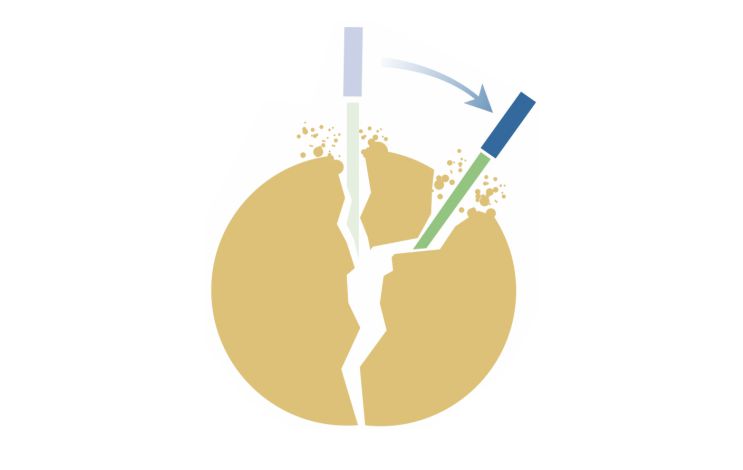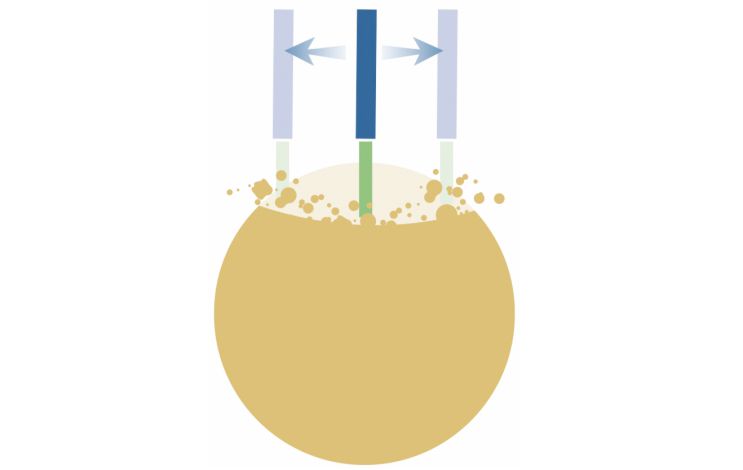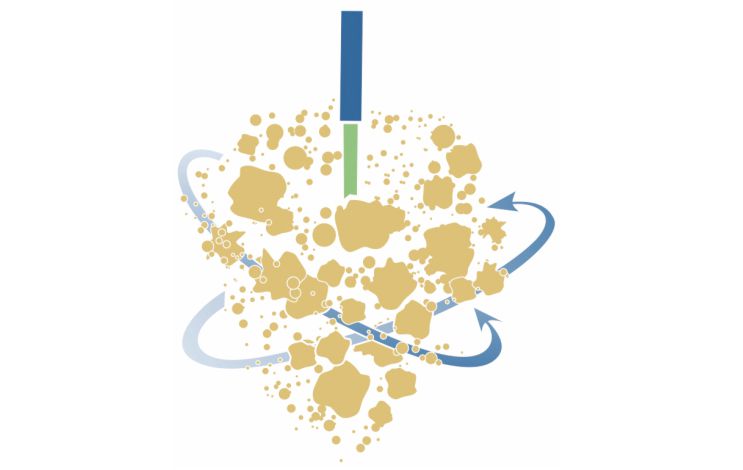Urolase SP
Innovative laser device for lithotripsy in the kidneys, ureters and bladder
Urology laser for lithotripsy
Urolase SP is an innovative and effective laser lithotripsy device. The combination of 1.94 µm wavelength and superpulse mode allows both fragmentation of concrements into large fragments for subsequent lithoextraction and atomization into microfragments, which are withdrawn independently without the use of additional equipment.
Urolase SP is used in rigid and flexible ureteronephroscopy, percutaneous, minipercutaneous, ultramini percutaneous and micropercutaneous surgeries.
Download Urolase SP brochure
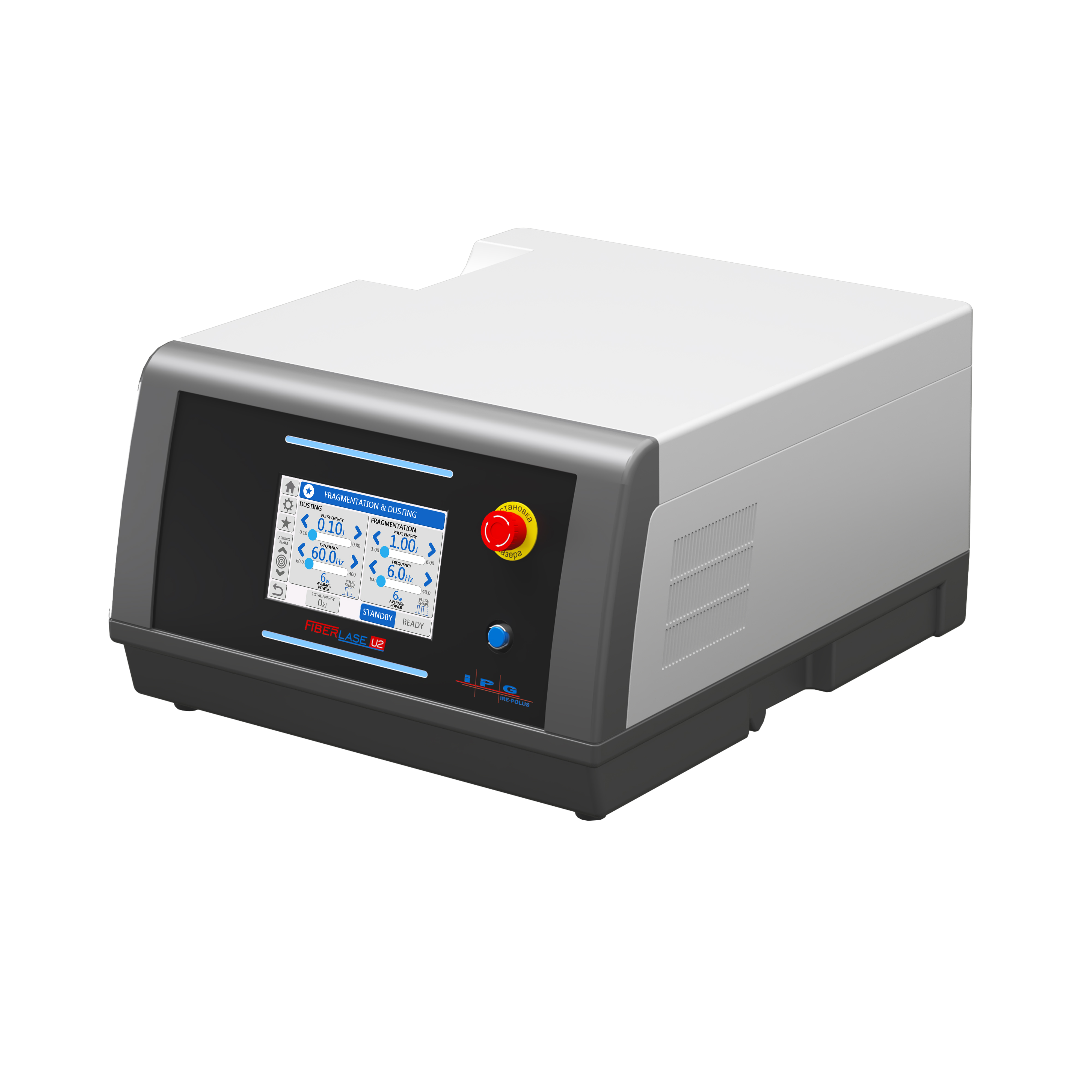
Urolase SP: Urology
Maximum reduction efficiency for all stone types, densities and sizes1
LITHOTRIPSY
- Fragmentation
- Dusting
- Popcorning

Fragmentation modes
Fragmentation
Fast and efficient lithotripsy mode. Energy settings of up to 6 J help to quickly break the stone into fragments suitable for extraction.
Dusting
The mode of stone crushing "in the dust" helps to remove stones from the ureter and kidney without the effect of retropulsion2 and the use of additional extractors.
Popcorning
A special mode for destroying stone fragments. This mode forms a " whirlwind" effect - fragments are attracted to the fiber tool and are gradually broken down into dust.
Thulium fiber lithotripsy is the most innovative technique for crushing urinary stones
This technology is recommended by the Russian Society of Urologists3
Retrograde intrarenal surgery. O. Traxer 2018
Micropercutaneous lithotripsy A. Martov 2019
List of publications about Urolase SP
| 1. Thulium fiber laser for lithotripsy of large renal stones: initial experience | O. Traxer, E. Keller, et al | WCE 2018 |
| 2. Preclinical comparison of superpulse thulium fiber laser and a holmium:YAG laser for lithotripsy | V. Andreeva, A. Vinarov, et al | World Journal of Urology volume 38, pages497–503(2020) |
| 3. The clinical guidelines. Urolithiasis. | А. Martov, R. Kharchilava et al. | МЗ РФ |
| 4. Clinical Comparison of Super Pulse Thulium Fiber Laser and High-Power Holmium Laser for Ureteral Stone Management | A. Martov, D. Ergakov, et al | Journal of Endourology Jan 2021 |
| 5. Comparison of single, dual, and staircase temporal pulse profiles for reducing stone retropulsion during thulium fiber laser lithotripsy in an in vitro stone phantom model | D. Gonzalez, V. Vinnichenko, et al | SPIE BiOS, 2019 |
IPG Surgical Fiber HP
Surgical fiber for laser urology
Bare fiber is ideal for open and endoscopic laser procedures in urology
IPG Surgical Fiber HP Multiple-Use (S) - Sterile reusable
IPG Surgical Fiber HP Single-Use (S) – Sterile disposable
FIND OUT MORE
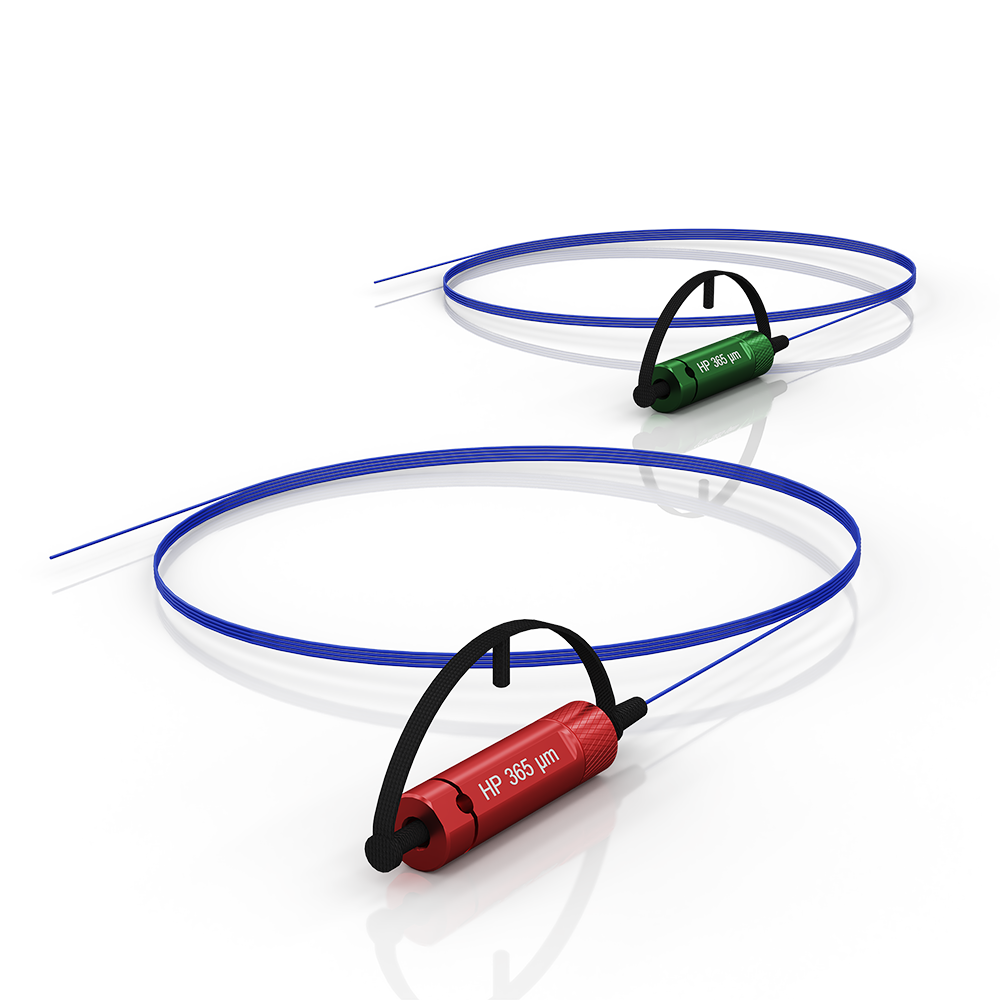
Distinctive features
- Wavelength 1.94 μm - optimal for lithotripsy
- The superimpulse mode of operation reduces stone retropulsion
- Possibility to crush stones into dust or large fragments
- Wide pulse energy range: 0.025 J to 4 J
- Maximum pulse repetition rate up to 1400 Hz
- Green pilot laser for best visibility against saturated tissue
- Dual pedal for combining modes
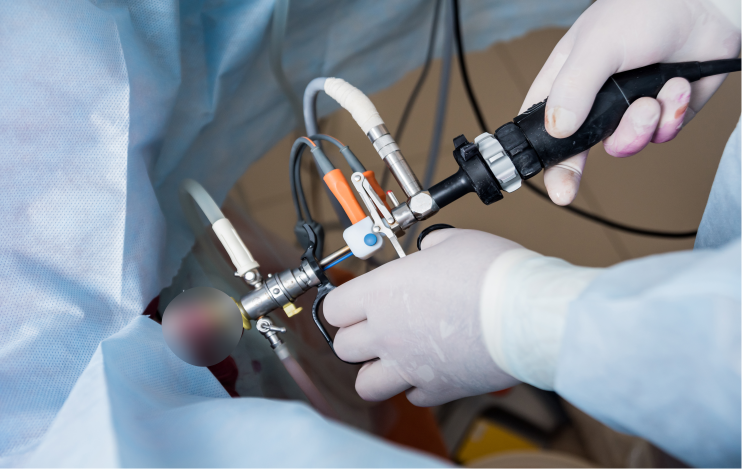
Fragmentation rate
Due to the high absorption in water of 1.94 µm wavelength and superpulse mode, the rate of fragmentation of concrements in "Dust" mode is twice as fast as that of holmium lasers4.

Minimal retropulsion
When comparing the effect of retropulsion in holmium lasers and superpulsed thulium fiber laser, it was proved that the TFL allows complete elimination of stone migration5.

HIGH PERFORMANCE PROPERTIES
Air cooling
Compact and reliable design, light weight
Can be connected to the standard power supply network
No regular maintenance required
List of publications about Urolase SP
| 1. Thulium fiber laser for lithotripsy of large renal stones: initial experience | O. Traxer, E. Keller, et al | WCE 2018 |
| 2. Preclinical comparison of superpulse thulium fiber laser and a holmium:YAG laser for lithotripsy | V. Andreeva, A. Vinarov, et al | World Journal of Urology volume 38, pages497–503(2020) |
| 3. Clinical guidelines. Urolithiasis. | А. Martov, R. Kharchilava et al. | МЗ РФ |
| 4. Clinical Comparison of Super Pulse Thulium Fiber Laser and High-Power Holmium Laser for Ureteral Stone Management | A. Martov, D. Ergakov, et al | Journal of Endourology Jan 2021 |
| 5. Comparison of single, dual, and staircase temporal pulse profiles for reducing stone retropulsion during thulium fiber laser lithotripsy in an in vitro stone phantom model | D. Gonzalez, V. Vinnichenko, et al | SPIE BiOS, 2019 |
| Wavelength, μm |
1.94 |
|
| Mode | SuperPulsed | CW |
| Maximum power, W | 40 | 40 |
| Pulse energy, J | 0.025...6 | - |
| Frequency, Hz | 1600 | - |
| Fiber diameter, μm | 150…1000 | |
| Cooling |
AIR |
|
| Supply voltage, V |
220±10 |
|
| Supply frequency, Hz | 50 … 60 | |
| Power consumption, VА max. | 1000 | |
| Dimensions (H*W*D), mm | 286*460*545 | |
| Weight, kg | 38 | |
In addition to the standard X-Y-Z axes and laser process head, there are several optional modules and accessories that may optimize the functionality of the system in your specific application. Below are some of the the most popular options.. Please contact IPG directly if you have additional requirements
Rotary Stage, A or
C axes, Direct Drive
High-precision, high-speed rotary stage with continuous motion synchronized to X-Y-Z axes
- Servo-driven rotary stage
- Brushless direct drive.
- Travel +/- 360° continuous
- Rotation speed: 600 rpm max
- Accuracy: 10 arc-sec
- Bi-directional repeatability: 4 arc-sec
- Pneumatic ER25 Collet Chuck
- Includes an additional axis of motion control
Rotary Stage, A or C axes, Gear Drive
Rotary stage with continuous motion synchronized to X-Y-Z axes
- Servo gear/belt-driven rotary stage
- Travel +/- 360° continuous
- Rotation speed: 30 rpm max
- Accuracy: +/- 180 arc-sec
- Bi-directional repeatability: +/- 45 arc-sec
- 5C Collet, 3 Jaw Chuck
- Includes an additional axis of motion control
Rotary Stage, B axis, Gear Drive
Rotary stage with continuous motion
- Servo gear/belt-driven rotary stage
- Travel +/- 90° continuous
- Rotation speed: 30 rpm max
- Accuracy: +/- 180 arc-sec
- Bi-directional repeatability: +/- 45 arc-sec
- Includes an additional axis of motion control
Coaxial Viewing Package
Camera system aligned with laser beam axis.
- Coaxial viewing system is integrated into laser head to provide live feedback on part positioning
- Package includes software with crosshair generator to display video feed
Power Meter
Laser power meter with stage-mounted detector for periodic verification of power on target. Useful for verifying performance of process head optics and coverslide.
Fume Extractor
- High flow-rate fume extractor for collection of smoke, fumes and air-borne debris.
- Flow rate of 380 m3/hr (220 cfm)
- 3-Stage filtering
- Reverse flow filter technology
- Real-time airflow reading
- Remote diagnostics
Automatic Doors
- Pneumatic actuator to automate slide door which can be controlled via HMI software or G-code
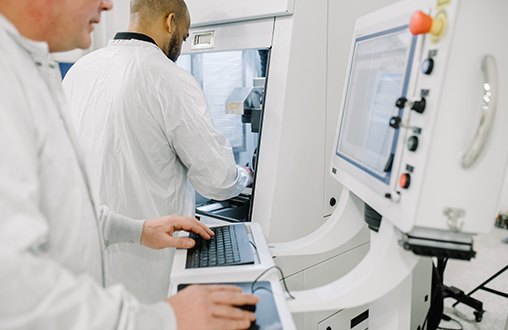
Multi-Axis Workstation Software
The Multi-Axis family of workstations are high-accuracy platforms designed to take advantage of the high beam quality found in IPG’s fiber lasers. Systems can be configured using any IPG laser, with laser processing heads available for welding, cutting and scanning applications. System options can include both basic and smart vision packages, along with part identification and process verification hardware.
The Multi-Axis software integrates control of the laser, motion systems and all system components to provide easy programming of the tool using G/M code commands that are familiar to CNC machine programmers.
HMI (Human Machine Interface)
The software that runs the Multi-Axis Workstations is a customized application called HMI (Human Machine Interface) that runs as a Microsoft Windows® 7 application. It is preloaded and tested at the IPG factory and resides in the workstation’s hard drive.
The HMI program consists of four primary regions:
- System Status Indicators – Providing a constant overview of the machine status, regardless of function selected
- Function Selection Bar – Providing primary selection of module operation
- Function Control Interface – Allows intuitive set up of configuration and operating parameters
- Manual Control Bar – Enabling manual operation of the systems global functions
Three Password-Protected Levels of System Control: Engineer, Maintenance and Operator.
User screens enable the Engineer, acting as system administrator, to easily set permission levels for each HMI screen for each level of operator and set corresponding passwords.
The system can operate in manual or programmed mode, and has functions to enable Dry-Run (execution of the full program but with the laser not turned on) and Optional Stop – that will allow a pause in the processing cycle for part inspection and other uses.
Used in combination with standard G-code programming, these capabilities provide the user with a comprehensive, easy-to-use programming and operator interface.


